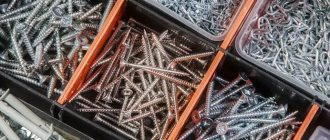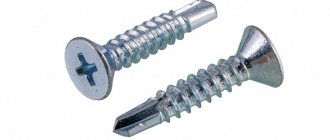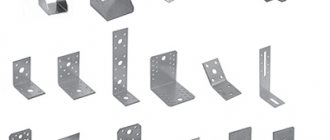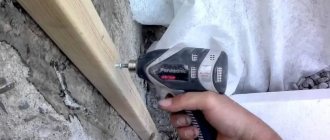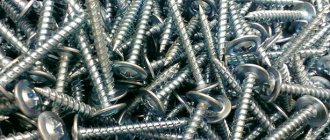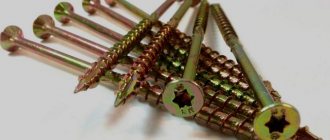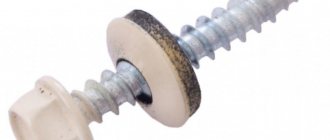Article reading time: 15 minutes
Author of the article:
Self-tapping screws are one of the most common types of fasteners in construction. They are easy to recognize by their design. A self-tapping screw has an elongated rod-shaped body with a threaded thread and a pointed end. At the opposite end there is a head with slots for a screwdriver or screwdriver bit. When screwing in hardware, the sharp end easily drills a hole in the material, the slots on the head allow you to create the necessary torque, and the threads ensure screwing and fixing the fastener.
Differences between self-tapping screws and self-tapping screws
GOST 27017-86 defines a screw as a fastener in the form of a rod with an external special thread, a threaded conical end and a head at the other end, forming a thread in the hole of the wooden or plastic product being connected. From this definition it becomes clear that a screw is screwed into a previously prepared hole and is used for fastening to wooden or plastic bases. Such screws, usually made from low-carbon steels (St1, St2, St3, 10kp), less often from corrosion-resistant steels without coating and from brass, have traditionally been produced and are still produced by the domestic hardware industry.
However, fasteners have long appeared on the Russian market that, by formal definition, correspond to the term “screw”, but have significant differences:
- their main structural elements have been fundamentally improved: heads, threads on the rod, ends and splines;
- High-quality steels and alloys with modern protective and decorative coatings were used.
As a result, the functionality of these products has significantly expanded:
- it has become possible to install them without pre-drilling holes, which significantly simplifies and speeds up the installation process of the fastened products;
- The range of materials in which these products can be installed has expanded: steel, aluminum and copper alloys, composite materials, concrete, and brick have been added to wood and plastic.
Such significant differences between new products and screws required the emergence of a special term. And such products began to be called self-tapping screws, in short - self-tapping screws.
The main structural elements of screws or self-tapping screws are:
- head - part of a fastener that has a rod, serving to transmit torque and form a supporting surface;
- slot - a specially shaped recess at the end of the head, which serves to transmit torque from the tool;
- threaded rod;
- end.
Self-tapping screw slots
There are quite a lot of varieties of recesses in the cap, which serve to transmit rotating force to the fastener rod. For self-tapping screws, 5 types are most common.
Straight spline
There is one slot made in the cap, which runs along the diameter of the circle and thus divides it into two equal parts. Developers of metal structures are gradually abandoning this oldest type of spline. The reasons are as follows:
- the bit or blade of a screwdriver is poorly fixed in it, as a result of which the recess, which initially has the correct shape, quickly “licks”;
- It is very difficult to unscrew fasteners with a “broken” slot.
Cross-shaped slot PH
The projection of a recess of this type is the intersection of two segments. When screwing, the tip of the tool comes into contact with four edges simultaneously, so this process is easier and, accordingly, faster.
When several screws are screwed in - 4-6 pieces - the difference in speed is practically unnoticeable. In the case of extensive installation work associated with the installation of 100-200 fasteners, the time savings will be very noticeable. It is allowed to designate self-tapping screws with a cross-shaped slot of type RN with one letter “H”.
Cross-shaped slot PZ
Another designation for such a recess is accepted - simply Z. Along with the four main slots, as is done in the PH self-tapping screws, the PZ head has the same number of additional ones, shifted by 45°, that is, they are bisectors of right angles between the original segments of the recesses. As a result, a total of 8 contact faces between the tool tip and the head are formed when screwing in fasteners of this type. For this reason, the likelihood of “licking” the slot is minimized.
Hexagon internal
Screwing is carried out using a 6-sided bit or a key. This model of self-tapping screw is rarely used in construction, but is widely used in furniture production.
Torx slot
The recess in the cap has the shape of a 6-pointed star. For screwing, an L-shaped key or a special bit of a response configuration is used. All 6 beams are made with the same size. This design solution provides:
- higher degree of impact on the fastener;
- better transmission of rotational force.
In terms of screwing reliability, Torx is superior to all other types of splines. Self-tapping screws with such a recess in the head are used in modern cellular communication devices, various power tools, vehicle components, household appliances, etc.
Main types of self-tapping screw heads
The use of one type of head or another is determined by the installation conditions and features. The most commonly used types of heads are:
- hexagonal - with a flat supporting surface protruding above the installation plane; used mainly on large screws or when fastening to metal bases, that is, in cases where the transmission of significant torques is required;
- semicircular - with a flat supporting surface protruding above the installation plane;
- cylindrical with a sphere, with a flat supporting surface, protruding above the installation plane;
- countersunk - with a conical supporting surface, recessed into the installation plane;
- countersunk - with a conical supporting surface and countersinking edges on it, recessed into the installation plane; countersinking edges prepare a recess for installing the product “in a countersunk” manner;
- semi-concealed - with a conical supporting surface, partially protruding above the installation plane; often used for decorative purposes;
- hidden horn - with a concave supporting surface, recessed into the installation plane; indispensable when fastening plasterboard boards, because provides easy and reliable penetration of the self-tapping screw “into the countersunk” without preliminary countersinking;
- flat with a press washer - with a supporting surface protruding above the installation plane;
- in the form of rings and hooks of different configurations protruding beyond the installation plane;
- in the form of a rod with a metric thread protruding beyond the installation plane.
With press washer
Self-tapping screws with a press washer have a galvanized coating. When installing products using such hardware, a hole is pre-drilled. Their difference is a hemispherical head with a press washer, as well as a slot for a Phillips screwdriver.
The press washer ensures firm pressing of thin parts. Even after time, the fastening does not become loose.
The following types of hardware are produced:
- With a drill.
- Spicy.
The first type is used for joining metal sheets. Sharp - for wooden panels. The length of the screws varies from 13 to 76 mm, and the nominal diameter is 4.2 mm.
Main types of self-tapping slots
The following types of self-tapping screw slots exist:
- direct, the most traditional, but recently used less and less;
- cross-shaped Ph or H (Phillips) replaced the straight slot and significantly accelerated the screwing process;
- cruciform Pz or Z (Pozidrive), thanks to a smaller angle at the apex and an improved shape of the internal recess, is able to transmit more torque without breaking the tool;
- star-shaped Torx allows even greater forces, but is less convenient due to the complex shape of the tool;
- internal hexagon, used to a limited extent, in particular when assembling furniture on ties (the so-called “Confirmat”).
General provisions
Why should you generally give preference to self-tapping screws when assembling wooden structures, rather than using time-tested nails? Let's look at the positive aspects this choice provides:
Advantages
- Simple operating instructions. You won’t hit your finger with a hammer, you won’t bend the product with an unsuccessful blow, you won’t get a callus on your palm out of habit, and you’ll fix wood fragments much faster than when using nails.
Screwing a self-tapping screw into a board with your own hands using a screwdriver
- More careful treatment of wood. Again, if we compare it with a nail, then, for example, it can split a plank if it gets between the fibers, and the hammer itself can damage the front surface of a wooden product when it misses. The fasteners in question are inserted carefully, practically without violating the integrity of the material.
- High reliability of fixation. The thread flanges and the head securely secure the joined fragments in the desired position.
- A wide range of. A huge number of models allows you to choose the ideal type of hardware for your specific case.
Flaw
There is only one significant disadvantage: the need for a screwdriver or other suitable electric tool for tightening self-tapping screws, which require additional financial costs. With a regular screwdriver, it will be very difficult to perform even small volumes.
Cordless screwdriver for tightening screws
The main dimensions of the slots of Phillips, Pozidrive, TORX screws
Each of the main types of splines also differs in size. In this case, for each type of spline a standardized and numbered row is formed:
- Phillips slots: Ph0, Ph1, Ph2, Ph3, Ph4;
- Pozidrive splines: Pz0, Pz1, Pz2 Pz3, Pz4;
- TORX slots: T (or TX) 2, 3, 4, 5, 6, 7, 8, 9, 10, 15, 20, 25, 27, 30, 40, 45, 50, 55, 60, 70, 80, 90, 100.
The differently positioned edges of the Pz slot form a more stable grip with the tool, which reduces its wear and reduces the likelihood of “breaking”. This makes it possible to apply more torque to the tool.
Russian version of the TORX slot according to GOST R ISO 10664-2007 (dimensions in mm)
For each type of slot and its size (number), a strictly appropriate tool is required: a screwdriver or a bit. Otherwise, rapid wear or even destruction of the drive elements is possible.
Methods of fastening to a brick wall
Soft method
This method is easy and quick to use, but unreliable - it is not suitable for heavy loads. But it is used for decoration and sheathing. This method can be used without the help of others, since it does not require construction skills. If you follow the instructions, the result will be satisfactory.
To perform fastening, you will need U-shaped metal brackets. They are fixed to the brick at a distance of 40 cm. At a level of half a meter from the floor, a 60 cm indent is made between them. The more fastenings, the more firmly the board holds. This will avoid deformation of the cladding. Under mechanical stress, the timber becomes loose and the structure is damaged. Therefore, be careful when working.
Main types of self-tapping screws
Depending on what materials need to be connected, choose a self-tapping screw with one or another type of thread. In this case, the following traditional quantitative characteristics for threads are taken into account:
- diameter;
- step;
- number of visits.
But besides them, the angle at the top of the thread profile α has a significant influence on the self-tapping properties of the product. The smaller the specified angle, the easier the product is twisted, the easier the thread is formed in the hole, and the higher the self-tapping properties.
Traditional screws produced by the domestic industry (GOST 1144-80, GOST 1145-80) have this angle equal to 60º, like a metric thread.
Modern self-tapping screws are made with an angle α=45º and less. Such sharp threads are especially effective when installing products in relatively soft materials: wood, chipboard, plastic, etc.
Self-tapping screws intended for screwing into metal (DIN 7976, 7981...7983) are made with large angles (mainly 60º) to increase the strength of the thread at the base of the profile. In addition, the cutting edge of the product is subjected to special hardening heat treatment, which ensures a hardness of 450HV. Metal self-tapping screws are highly standardized products and their threads are manufactured according to ISO 1478, EN 2478, DIN 7970 standards. In the drawing and design documentation, the letters ST (SCREW THREADS) are placed in front of the diameter of their threads.
The table shows the main dimensions for sharp (type C) and blunt (type F) ends.
To reduce the time of screwing into wood, as well as to prevent cracking of wood, special notches are used on the thread, creating additional cutting edges, and the actual wavy cutting edge of the thread.
For corrugated sheets
To perform roofing or facade work, it is necessary to fasten metal tiles and metal profiles. For this, special galvanized screws for corrugated sheets are used. They look like screws with a polymer or galvanized coating. The polymer coating can be matched to the color of the corrugated sheet.
The set of such hardware includes a neoprene washer, which prevents moisture from entering the mounting location. Corrugated sheeting can be used for:
- Roofs.
- Fence.
- Stan.
Roofing screws for corrugated sheeting are available in lengths from 190 to 250 mm, and a nominal diameter of 4.8 - 6.3 mm. To correctly select the length of the hardware, it should be taken into account that its thread is 3 mm longer than the material being connected. This significantly increases the quality of fastening. To calculate the quantity, you usually take 8 self-tapping screws per 1 sheet of corrugated sheeting.
Self-tapping screws with a press washer are used for fences and walls. These screws are also available in different colors.
Main types of self-tapping screw ends
Depending on the installation technology, the self-tapping screw should be selected with one end or the other. The most common screws are those with a traditional sharp end, which may differ from each other in the angle of entry β. It is clear that as it decreases, the introduction of the rod into the material becomes easier and the self-tapping properties of the product increase.
For traditional screws (according to GOST 1144-80, GOST 1145-80, GOST 1146-80) this angle is 40°.
For popular drywall screws (the so-called “black”) it is much smaller: 26...280. Widespread universal ones have even less: 20...300.
To increase self-tapping properties, special end designs are used.
The most effective in this regard are self-tapping screws with a drill (drill-tip). During installation, they act like a sequentially working drill and self-tapping screw. First, the drill creates a hole in the base material, and then a self-tapping screw is screwed into it. Thus, installation occurs as a single screwing operation.
A tapping screw has a tap-like end that it uses to cut metric threads into a pre-drilled hole.
The end on a triangular rod with a leading part and a smooth thread run-out is characteristic of the so-called thread extrusion screw. It is screwed into a smooth hole, in which the corresponding thread is rolled out. This is convenient when installing products with one-way access and significantly increases the connection density, especially with a metal sheet.
The end of a Flügel-type drill-tip screw, designed for fastening wood to metal, has special wings on the transition part from the drilling tip to the thread. They make a hole in the wood and are cut on a metal surface. Next, the external thread of the screw forms a counter thread in the metal.
Self-tapping screws for special purposes
Scope of use is one of the frequently used criteria on the basis of which self-tapping screws are divided into types. There are universal types. They can be used both when assembling special structures in the form of shelving, and for fixing planks. But the industry also produces highly specialized hardware. Their incorrect use can cause destruction of the material or weakening of the connection.
Roofing screws
Scope of application – securing materials with a thickness exceeding 6.0 mm, used in roofing. These can be metal tiles and corrugated sheets. The screw head has a 6-sided configuration. This design solution provides better transmission of rotational force from the impact wrench.
To increase the pressure area, there is a washer under the hardware head. But that's not all! To ensure that the roof does not lose its tightness at the fastening points, a gasket made of technical rubber is located under the washer.
Due to the inevitable exposure of self-tapping screws to precipitation, they are galvanized. The pitch of thread knurling is frequent. This ensures reliable retention of roofing materials on the roof sheathing under significant wind loads and considerable displacement effects of a thick layer of snow. The thread can be single- or double-start.
Self-tapping screws for fastening sandwich panels
First of all, it is necessary to note the design feature of sandwich panels. It consists in the fact that steel sheets act as a frame for the foam filler. This combination of materials can be easily drilled out with special self-tapping screws with a drill bit at the end. The threaded turns following it provide a reliable tie.
A 6-sided head for a socket or an open-end wrench perfectly transmits rotating force to the rod. The connection achieves the required level of tightness due to tight pressure with a steel washer and a rubber gasket. The requirements for the thickness of the base, suitable for fixation with self-tapping screws of this type, look like this:
- minimum – 1.5 mm;
- maximum – 12.0 mm.
Self-tapping screws for installing window profiles
These are self-tapping screws with a drill bit and a countersunk head. Thread knurling pitch is medium. Used in two cases:
- for fastening the metal profile itself in the window opening;
- when it is necessary to fasten other elements to an already installed metal profile, for example, an opening degree limiter or a device in the form of a hinge.
Covered with a layer of zinc. As a result, it turns white or yellow. This procedure is designed to prevent the self-tapping screw from rusting when window condensation gets on it.
Self-tapping screws for concrete
This type of fastener has a special name – dowel. Used to attach structural elements to an installation base characterized by increased hardness. This can be not only concrete, but also a wall decorative and protective panel, a subfloor - cement screed, and also brick.
Can independently withstand light loads (small lighting fixtures, shelves, holders). If it is necessary to hang more massive objects, it is used in conjunction with a spacer dowel. Before installation, you need to punch a hole using a hammer drill. The dowel cap comes in two types: cylindrical and recessed.
Reliability of fixation is ensured by:
- uneven thread knurling, the height of the threads in which is periodically interrupted;
- axial displacement of such sections of threaded thread.
When installing in drywall or wood, there is no need to pre-drill a hole.
Structural self-tapping screw
The cap can be recessed or hemispherical, equipped with a pressure washer. All hardware is galvanized, as a result of which its surface acquires a silver or yellow tint. It is used in the field of log-frame construction to tie wood. There is no need to create a socket beforehand for screwing. Compared to the perforated method of fastening using corners that already have holes, the use of structural self-tapping screws saves installation time by up to 50%.
The smooth segment under the head provides better tightening. In an open rafter system, fasteners are not noticeable, which increases the aesthetic perception of the building. From the outside it seems that the structure was erected using ancient technology, called “without a single nail.”
Self-tapping furniture screws
In technical documentation, such fasteners may be referred to as “Euroscrew” or “confirmed”. It is used on an industrial scale exclusively in the production of furniture. In particular, with the help of these parts overlap, T-shaped and corner mates of elements of furniture sets are formed. The rod has a sparse thread knurling, and its end is not pointed, but blunt. Therefore, to install this hardware, you need to pre-drill a hole.
Between the flat cap and the rod there is a cylindrical thickening. It helps to increase clamping force. In the head of the furniture self-tapping screw, there is a recess made for screwing it in for a screw key. Plastic plugs are used to hide the fasteners.
Confirmations
A separate line worth noting is the self-tapping screw - a confirmat, specially created for the manufacture of furniture from wood and chipboard.
The confirmat type self-tapping screw, with a clean surface and a large area of the lateral surface of the thread, allows you to obtain a high-strength and precise connection of elements. Before screwing the confirmat, a hole with a diameter of 4.5 or 7 mm is required, respectively. The confirmation head is made for a hex key. To hide the head of a tightened self-tapping screw, Confirmat produces decorative plastic buttons - plugs of any color. The plug with its protrusion is tightly inserted into the hexagonal hole of the confirmation head and disguises it to match the color of the furniture. In our online store “Izh-Tandem Market” you can choose and buy universal self-tapping screws, for drywall, metal, window, roofing screws and for other types of work, with delivery throughout the city of Izhevsk or pick-up from a pick-up point at the address : Izhevsk, st. Promyshlennaya, 31
.
